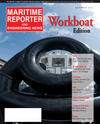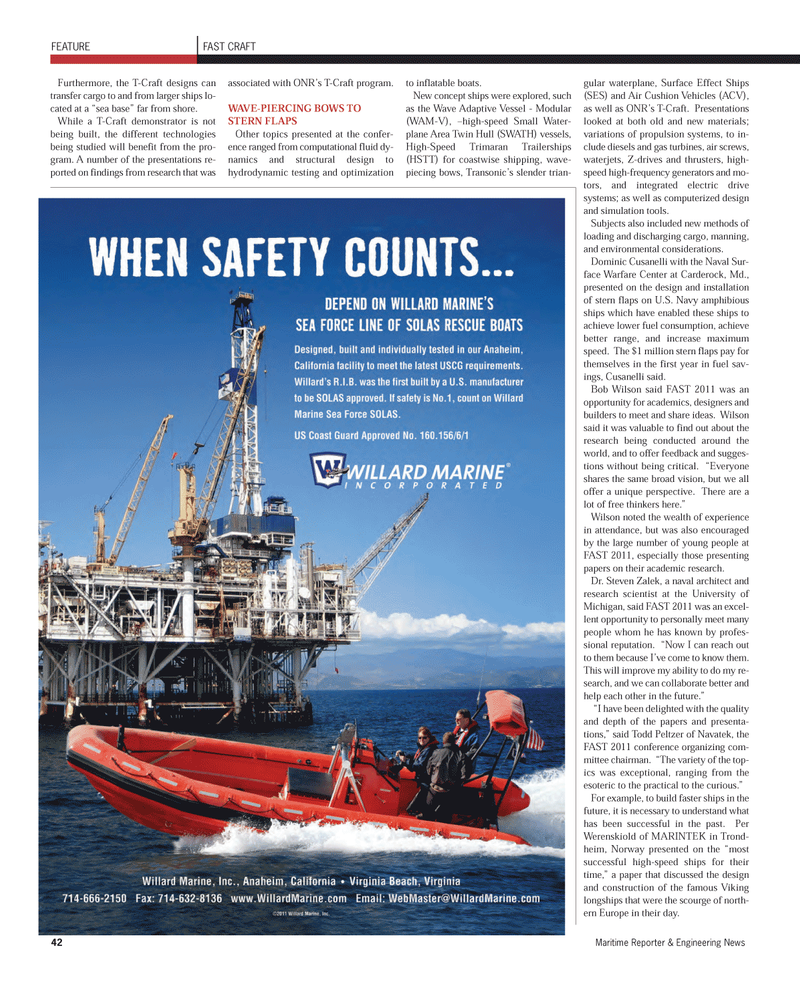
Page 42: of Maritime Reporter Magazine (November 2011)
Feature: Workboat Annual
Read this page in Pdf, Flash or Html5 edition of November 2011 Maritime Reporter Magazine
Furthermore, the T-Craft designs can transfer cargo to and from larger ships lo- cated at a ?sea base? far from shore. While a T-Craft demonstrator is not being built, the different technologies being studied will benefit from the pro- gram. A number of the presentations re- ported on findings from research that was associated with ONR?s T-Craft program. WAVE-PIERCING BOWS TO STERN FLAPSOther topics presented at the confer- ence ranged from computational fluid dy-namics and structural design tohydrodynamic testing and optimizationto inflatable boats.New concept ships were explored, such as the Wave Adaptive Vessel - Modular (WAM-V), ?high-speed Small Water- plane Area Twin Hull (SWATH) vessels, High-Speed Trimaran Trailerships (HSTT) for coastwise shipping, wave- piecing bows, Transonic?s slender trian- gular waterplane, Surface Effect Ships (SES) and Air Cushion Vehicles (ACV), as well as ONR?s T-Craft. Presentations looked at both old and new materials; variations of propulsion systems, to in- clude diesels and gas turbines, air screws, waterjets, Z-drives and thrusters, high- speed high-frequency generators and mo- tors, and integrated electric drive systems; as well as computerized designand simulation tools. Subjects also included new methods of loading and discharging cargo, manning, and environmental considerations. Dominic Cusanelli with the Naval Sur- face Warfare Center at Carderock, Md., presented on the design and installationof stern flaps on U.S. Navy amphibious ships which have enabled these ships to achieve lower fuel consumption, achieve better range, and increase maximumspeed. The $1 million stern flaps pay for themselves in the first year in fuel sav- ings, Cusanelli said.Bob Wilson said FAST 2011 was an opportunity for academics, designers andbuilders to meet and share ideas. Wilson said it was valuable to find out about the research being conducted around theworld, and to offer feedback and sugges- tions without being critical. ?Everyone shares the same broad vision, but we all offer a unique perspective. There are a lot of free thinkers here.? Wilson noted the wealth of experience in attendance, but was also encouraged by the large number of young people at FAST 2011, especially those presenting papers on their academic research.Dr. Steven Zalek, a naval architect and research scientist at the University of Michigan, said FAST 2011 was an excel- lent opportunity to personally meet many people whom he has known by profes- sional reputation. ?Now I can reach out to them because I?ve come to know them. This will improve my ability to do my re- search, and we can collaborate better andhelp each other in the future.? ?I have been delighted with the quality and depth of the papers and presenta-tions,? said Todd Peltzer of Navatek, the FAST 2011 conference organizing com- mittee chairman. ?The variety of the top- ics was exceptional, ranging from the esoteric to the practical to the curious.? For example, to build faster ships in the future, it is necessary to understand whathas been successful in the past. PerWerenskiold of MARINTEK in Trond- heim, Norway presented on the ?most successful high-speed ships for theirtime,? a paper that discussed the design and construction of the famous Viking longships that were the scourge of north- ern Europe in their day. 42Maritime Reporter & Engineering News FEATURE FAST CRAFT MR Nov.11 # 6 (42-49):MR Template 10/28/2011 11:58 AM Page 42

 41
41

 43
43
